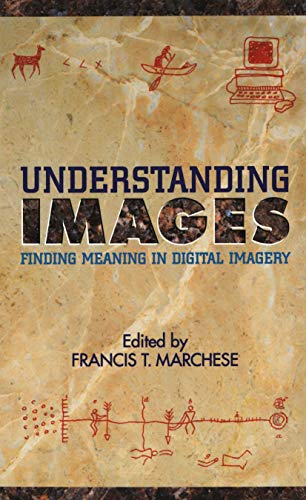
1995, ISBN: 9780387941486
Editor: Marchese, Francis T. Springer, Hardcover, Auflage: 1995, 328 Seiten, Publiziert: 1995-01-20T00:00:01Z, Produktgruppe: Book, 0.65 kg, Verkaufsrang: 9586070, AI & Machine Learning, … Plus…
| amazon.com Bakabush Books Frais d'envoiIn Stock. Real shipping costs can differ from the ones shown here. (EUR 3.73) Details... |

1995, ISBN: 0387941487
[EAN: 9780387941486], Used, very good, [PU: Springer/Sci-Tech/Trade 1995-01-20], Item is in very good condition. If supplemental codes/CDs for textbooks are required please contact us pri… Plus…
| AbeBooks.com LowKeyBooks, Sumas, WA, U.S.A. [65875000] [Rating: 5 (of 5)] NOT NEW BOOK. Frais d'envoiFree shipping. (EUR 0.00) Details... |
![Understanding Images: Finding Meaning in Digital Imagery - Marchese, Francis T. [Editor]](https://images.eurobuch.ch/buch/cover/OTc4MDM4Nzk0MTQ4NjtodHRwczovL2ltYWdlcy5ldXJvYnVjaC5jaC9pbWFnZXMvZnIvcGFydHMvY292ZXJfdmVyZ3JpZmZlbi5wbmc%3D.png)
1995, ISBN: 9780387941486
Hardcover, New book, Size: 9x6x0; New. In shrink wrap. Looks like an interesting title!, [PU: Springer]
| alibris.com |

1995, ISBN: 0387941487
[EAN: 9780387941486], New book, [PU: Springer], Books
| AbeBooks.com Books of the Smoky Mountains, Pflugerville, TX, U.S.A. [83070900] [Rating: 5 (of 5)] NEW BOOK. Frais d'envoi EUR 3.00 Details... |

ISBN: 9780387941486
Springer, 1995. 1st. Hardcover. New/New., Springer, 1995, 6
 | Biblio.co.uk |


1995, ISBN: 9780387941486
Editor: Marchese, Francis T. Springer, Hardcover, Auflage: 1995, 328 Seiten, Publiziert: 1995-01-20T00:00:01Z, Produktgruppe: Book, 0.65 kg, Verkaufsrang: 9586070, AI & Machine Learning, … Plus…

Marchese, Francis T.:
Understanding Images: Finding Meaning in Digital Imagery - edition reliée, livre de poche1995, ISBN: 0387941487
[EAN: 9780387941486], Used, very good, [PU: Springer/Sci-Tech/Trade 1995-01-20], Item is in very good condition. If supplemental codes/CDs for textbooks are required please contact us pri… Plus…
1995
ISBN: 9780387941486
Hardcover, New book, Size: 9x6x0; New. In shrink wrap. Looks like an interesting title!, [PU: Springer]
ISBN: 9780387941486
Springer, 1995. 1st. Hardcover. New/New., Springer, 1995, 6
Données bibliographiques du meilleur livre correspondant
| Auteur: | |
| Titre: | |
| ISBN: |
Informations détaillées sur le livre - Understanding Images: Finding Meaning in Digital Imagery
EAN (ISBN-13): 9780387941486
ISBN (ISBN-10): 0387941487
Version reliée
Date de parution: 1995
Editeur: Springer
Livre dans la base de données depuis 2007-04-30T02:20:22+02:00 (Zurich)
Page de détail modifiée en dernier sur 2023-06-08T15:49:12+02:00 (Zurich)
ISBN/EAN: 0387941487
ISBN - Autres types d'écriture:
0-387-94148-7, 978-0-387-94148-6
Autres types d'écriture et termes associés:
Auteur du livre: marchesi, marchese
Titre du livre: digital imagery, doing images, understanding understanding, francis meaning
Données de l'éditeur
Auteur: Francis T. Marchese
Titre: Understanding Images - Finding Meaning in Digital Imagery
Editeur: Springer; Springer US
316 Pages
Date de parution: 1995-01-20
New York; NY; US
Poids: 0,652 kg
Langue: Anglais
112,34 € (DE)
115,49 € (AT)
124,00 CHF (CH)
Contact supplier
XII, 316 p.
BB; Image Processing and Computer Vision; Hardcover, Softcover / Informatik, EDV/Anwendungs-Software; Maschinelles Sehen, Bildverstehen; Verstehen; computer visualization; complexity; Complexity; Data Structures and Information Theory; Mathematical Methods in Physics; Numerical and Computational Physics, Simulation; Computer Vision; Applied Dynamical Systems; Data Structures and Information Theory; Mathematical Methods in Physics; Theoretical, Mathematical and Computational Physics; Mathematik für Ingenieure; Kybernetik und Systemtheorie; Algorithmen und Datenstrukturen; Informationstheorie; Mathematische Physik; BC; EA
1 Editor’s Introduction.- 1.1 References.- 2 Lipstick on the Bulldog.- 2.1 Introduction.- 2.2 A Few Definitions.- 2.3 Why Collaboration is Hard to Do.- 2.4 Process, Tools, Product.- 2.5 Strategists or Service Bureaus.- 2.6 Education.- 2.7 Common Ground.- 3 Photographic Interpretation.- 3.1 Introduction.- 3.2 Questions and Answers.- 4 Cognitive Origins of Graphic Productions.- 4.1 Introduction.- 4.1.1 Elemental and Relational Concepts.- 4.1.2 How Depictions are used to Convey Meaning.- 4.2 Pictographs and Symbols.- 4.2.1 General Principles.- 4.2.2 Children’s Early Writing.- 4.2.3 Children’s Early Arithmetic.- 4.2.4 Historical Examples of Arithmetic.- 4.2.5 Historical and Developmental Parallels in Arithmetic Representations.- 4.3 Pictorial Space and Pictorial Devices.- 4.3.1 Children’s Graphic Productions.- 4.3.2 Spatial Pictorial Devices.- 4.4 Conclusions.- 4.4.1 Ontogeny Recapitulates Phylogeny.- 4.4.2 Two Aspects of Meaning and Two Aspects of Representations.- 4.4.3 Cognitive Naturalness.- 4.5 Acknowledgements.- 4.6 References.- 5 Automating Procedures for Generating Chinese Characters.- 5.1 Introduction.- 5.2 The Case for Chinese Characters.- 5.3 Introduction to Chinese Characters.- 5.4 Current Software Capabilities.- 5.5 The Path Based Bezier Curve Approach.- 5.6 References.- 6 Multimedia Representational Aids in Urban Planning Support Systems.- 6.1 Introduction.- 6.2 Challenges to Urban Planning Support Systems.- 6.3 Addressing the Challenges: Representational Aids.- 6.4 Input Aids.- 6.5 Output Aids.- 6.6 Application of Representational Aids: Rantoul, Illinois.- 6.7 Conclusions.- 6.8 Acknowledgements.- 6.9 References.- 7 Gesture Translation:Using Conventional Musical Instruments in Unconventional Ways.- 7.1 Introduction.- 7.2 The Need for Something Better.- 7.3 Gesture Translation.- 7.4 The Current System.- 7.5 An Example.- 7.6 Related Work.- 7.7 Limitations and Future Work.- 7.8 Conclusion.- 7.9 References.- 8 Visualization for Personal Information Systems.- 8.1 Introduction.- 8.2 Personal Information Systems.- 8.3 Personal Knowledge Space.- 8.4 Discussion.- 8.4.1 Visual Familiarity.- 8.4.2 Links by Associations.- 8.4.3 Filters and Monitors.- 8.5 Summary and Future Research.- 8.6 References.- 9 Blazon Computer Graphic Notation.- 9.1 Overview and Background.- 9.2 Basic Terms and Definitions.- 9.2.1 The Field and the Points of the Field.- 9.2.2 The Plain Shield: Tinctures, Metals, Furs, Tricks.- 9.2.3 Partitioning the Shield and the Ordinaries.- 9.2.4 The Thirds Ordinaries.- 9.2.5 Sub-Ordinaries and Discrete Charges.- 9.2.6 Repetition of Form.- 9.2.7 Partition Lines, Diminutives, and Borders.- 9.3 The Marshalling of Arms.- 9.4 Summary of Blazon.- 9.5 References.- 10 Masaccio’s Bag of Tricks.- 10.1 Introduction.- 10.2 The Perspective and Plan of Masaccio’s Trinity.- 10.2.1 The Ground Plan of G. F. Kern (1913).- 10.2.2 The Ground Plan of Sanpaolesi (1962).- 10.2.3 Janson’s Ground Plan (1967).- 10.2.4 Kemp’s Plans for the Trinity (1981, 1990).- 10.2.5 Proposed Plan and Elevation for Masaccio’s Trinity.- 10.3 Convincing Realism or Subtle Rhetoric Tricks?.- 10.3.1 Control of Space.- 10.3.2 Concessions to Surface Arrangement.- 10.3.3 Amplification of the Newly Discovered Device.- 10.4 Conclusion.- 10.5 Acknowledgements.- 10.6 References.- 11 Is Alligator Skin More Wrinkled Than Tree Bark?.- 11.1 Introduction.- 11.2 Benefits of This Research.- 11.3 Primary versus Secondary Properties of Objects.- 11.3.1 Problems and Clarifications.- 11.4 How to Think About Texture.- 11.4.1 Texture as a Property of Visual Surfaces: Secondary and Non-objective (Qualitative).- 11.5 Understanding Features Humans Use in Texture Perception.- 11.5.1 A Comparison With Color.- 11.5.2 Computer Perception of Texture.- 11.5.3 Identifiying the Dimensions of Visual Texture.- 11.6 Experiments on the Categorization of Texture Words.- 11.7 Conclusion.- 11.8 References.- 12 Variability and Universality in Human Image Processing.- 12.1 Introduction.- 12.2 Background.- 12.2.1 New Research Paradigm (View Four): Implications for a New View of Variability and Universality.- 12.2.2 Technological Developments and Understanding Imagery.- 12.2.3 Cultural Basis for Seeing Human Variability as Problematic.- 12.3 An Information Oriented Model for Understanding Imagery.- 12.3.1 Attention, Selection, and Interpretation.- 12.3.2 Color.- 12.3.3 Serial/Parallel Processing.- 12.3.4 Early Research on Human Image Processing.- 12.3.5 Recent Research in Human Image Processing.- 12.3.6 Imagery Debate.- 12.4 References.- 13 Aesthetics and Nature.- 13.1 Introduction.- 13.2 Scientific Visualization as a Coherent Window into a (Fragmented) World.- 13.3 Spatial and Temporal (Dis)continuities.- 13.4 The Multiple Roles of the Visualization Expert.- 13.4.1 Collaborator with Scientific Researchers.- 13.4.2 Artist.- 13.4.3 Educator.- 13.4.4 Manufacturer of Evidence.- 13.5 Case Studies.- 13.5.1 Simulated Tornadic Storm Development.- 13.5.2 Study of a Numerically Modeled Severe Storm.- 13.5.3 Visibility Analysis Through the Animation of a Backhoe Work Cycle.- 13.6 Conclusion.- 13.7 References.- 14 Crossroads in Virtual Reality.- 14.1 Introduction.- 14.2 The Meanings of Virtual Reality, Virtual Worlds, Virtual Environments.- 14.2.1 Simulation.- 14.2.2 Interaction.- 14.2.3 Artificiality.- 14.2.4 Immersion.- 14.2.5 Telepresence.- 14.2.6 Full-Body Immersion.- 14.2.7 Networked Communications.- 14.3 VR Projection Images Do Not Re-Present, They Tele-Present.- 14.3.1 Tunnel Graphics and Boomerang Graphics: Perception and Apperception.- 14.3.2 The Hope of a Complementary System.- 14.4 References.- 15 Audio Display from the Simple Beep to Sonification and Virtual Auditory Environments.- 15.1 Introduction.- 15.2 Motivations for the Use of Audio.- 15.3 Auditory Perception.- 15.4 Auditory Scene Analysis.- 15.5 Detectability and Masking.- 15.6 The Psychology of Everyday Listening.- 15.7 Approaches and Applications of Audio Displays.- 15.7.1 Warnings and Alarms.- 15.7.2 Status Information — Auditory Icons: Gaver.- 15.8 Displaying Abstract Data: Sonification and Auralization.- 15.8.1 Sonification: Bly.- 15.8.2 Sonification of Chemical Spectra: Lunney & Morrison.- 15.8.3 Sonification of Multivariate Time Series Data: Mezrich, Frysinger, & Slivjanovski.- 15.8.4 Exploratory Visualization Project: Smith, Bergeron, & Grinstein.- 15.8.5 Earcons: Blattner, Sumikawa, & Greenberg.- 15.9 Virtual Auditory Worlds.- 15.9.1 Wenzel: Implications for a Virtual Acoustic Display of Individual Differences in HRTFs.- 15.10 Future Research.- 15.10.1 Enhanced Localization Cues.- 15.10.2 Representational Sounds: Automatic Foley Generation.- 15.10.3 Transduced Telepresence Audio, Spatialized Sonification, and the Integration of Virtual Acoustic Display.- 15.11 Implementation Issues.- 15.12 Conclusions.- 15.13 References.- 16 Contibutors.Autres livres qui pourraient ressembler au livre recherché:
Dernier livre similaire:
9781461383826 Understanding Images (Francis T. Marchese)
< pour archiver...



